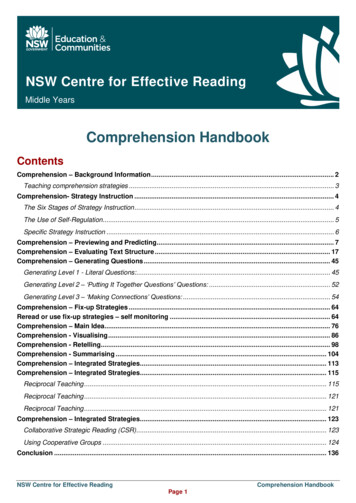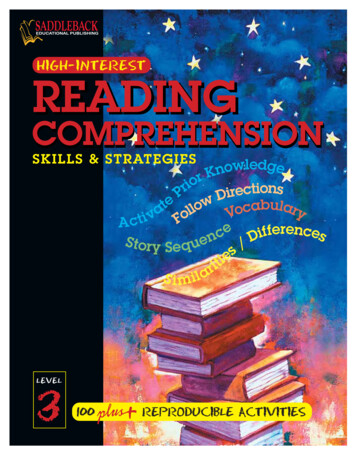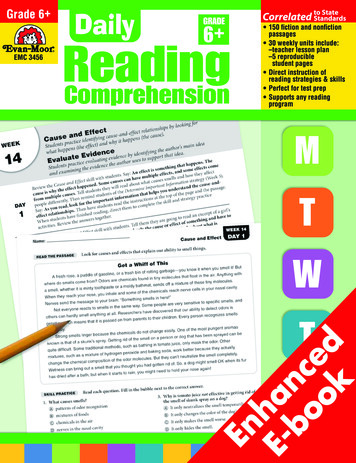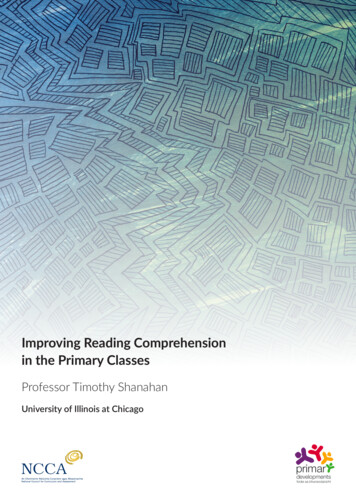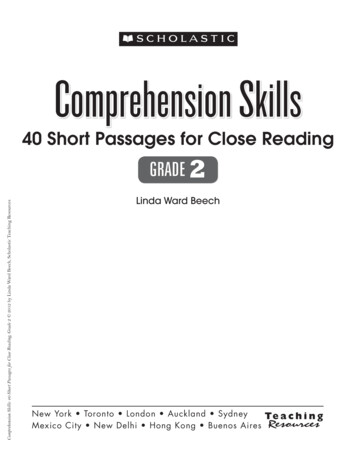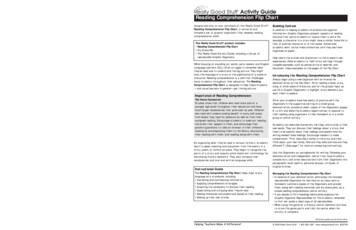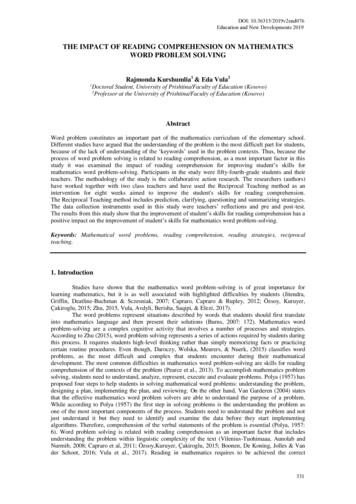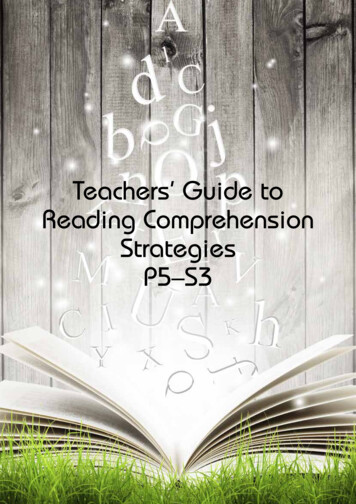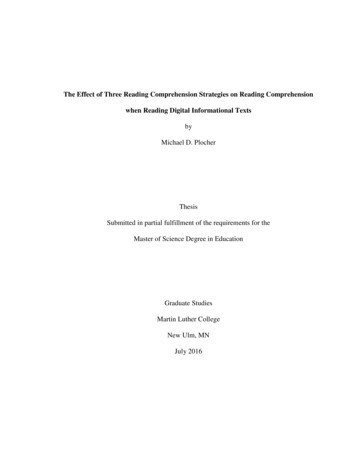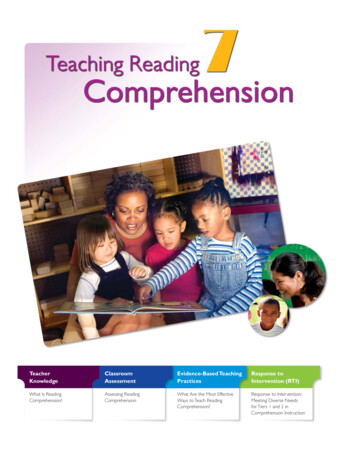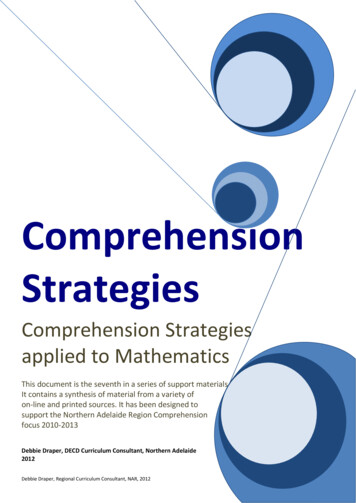
Transcription
ComprehensionStrategiesComprehension Strategiesapplied to MathematicsThis document is the seventh in a series of support materials.It contains a synthesis of material from a variety ofon-line and printed sources. It has been designed tosupport the Northern Adelaide Region Comprehensionfocus 2010-2013Debbie Draper, DECD Curriculum Consultant, Northern Adelaide2012Debbie Draper, Regional Curriculum Consultant, NAR, 20121
Comprehension and Mathematics: Comprehension Strategies applied to MathematicsIn order for students to be successful in the maths classroom they must be able to find the meaning of a mathsproblem and look for approaches to a possible solution. Students must analyse and make conjectures aboutinformation. They need to analyse situations to make connections and plan solutions. Reading comprehension andwriting strategies are parallel to strategies students need to be mathematically proficient.Much like literacy, students need to self-monitor, evaluate their progress and ask questions when necessary. Theyneed to be flexible in using different properties of math operations. They need to move freely and fluently betweenequations, verbal descriptions, tables, graphs, etc. Students need to verify their answers to math problem solvingpieces just as students need to monitor for meaning while reading. They continually need to ask themselves, doesthis make sense? Asking questions is at the heart of a thoughtful reader and it is also at the heart of a goodmathematician.As with literacy, students need to clearly share their thinking and understand that there are many approaches tosolving complex problems. Middle level math students need to be able to transform math problems into algebraicexpressions representing a problem symbolically. Students need to be able to make justifications and supportmathematical arguments. They need to make conjectures and build a logical progression of ideas to support them.They need to communicate concisely and use precise vocabulary and symbols to justify their conclusions.Students often get confused because words and phrases that mean one thing in the world of mathematics meananother in every day context. For example, the word “similar” means “alike” in everyday usage, whereas inmathematics similar has to have proportionality. For example “similar” figures must have a relationship wherecorresponding sides of two shapes are proportional and corresponding angles are equal. “Similar” in mathematics, aswith many other vocabulary words, has a much more profound meaning than in every day usage.In addition to vocabulary, math has specialised symbols and technical language that students find confusing. Mathoperations have a variety of ways they can be represented. Symbols may be confusing because they look alike. Forexample the division and square root symbols are visually similar but have very different meanings. Differentrepresentations may be used to describe the same process such as, 2 3, 2*3, (2)(3) and 2 3 all have the sameimplications for multiplication. In literacy students need to be cognisant of the fact that homophones andhomonyms have different spellings and meanings. Likewise, students need to be aware of confusing mathematicalterms and symbols and have the strategies to deal with them when being a mathematician.For this reason, math classroom environments need to provide rich text, print and mathematical representations.Word walls are a technique that many classroom teachers use to help student become fluent with the language ofmathematics. It is vital that vocabulary be taught as part of a lesson and not be taught as a separate activity.As with literacy strategies, modeling is an essential and significant step for teaching math strategies. People whoteach math must be mathematicians. Teachers must show students that math is not always easy for them and modelhow they genuinely struggle with problems. Students often struggle to understand the meaning of content area text.Teachers must give students the strategies and tools to tackle challenging mathematics. Students must be awarethat struggling with content is necessary and a vital part of the learning process. Modeling helps teachers to buildconfidence and trust in their students giving them strategies to grapple with challenging material.Visualising is an especially helpful strategy for the math student as it is for the literacy student. In order to solve themath problems, students should be urged to diagram how they interpret the math text. The students’ diagrams canalso be used as formative assessment. The teacher can identify misconceptions the students may have around themath content and use the information to intervene.Students need to be aware that the strategies are very much the same and can be used across content areas.Students often times feel that they are learning everything in isolation. We as educators need to help students seethat there are connections between content areas and help them make these connections on a daily basis.Debbie Draper, Regional Curriculum Consultant, NAR, 20122
Monitoring ComprehensionOnce you look at a "word problem," the reading connection is obvious. If a child is not a fluent reader and has tofigure out the words in slow, often inaccurate, manner, there is little or no chance for the problem to be understood.But the connection goes deeper than this.In order for students to be successful in the math classroom they must be able to find the meaning of a mathproblem and look for approaches to a possible solution. Students must analyse and make conjectures aboutinformation. They need to analyse situations to make connections and plan solutions. Reading comprehension andwriting strategies are parallel to strategies students need to be mathematically proficient.Much like literacy, students need to self-monitor, evaluate their progress and ask questions when necessary. Theyneed to be flexible in using different properties of math operations. They need to move freely and fluently betweenequations, verbal descriptions, tables, graphs, etc.Students need to verify their answers to math problem solving pieces just as students need to monitor formeaning while reading. They continually need to ask themselves, does this make sense? Asking questions is at theheart of a thoughtful reader and it is also at the heart of a good mathematician.Debbie Draper, Regional Curriculum Consultant, NAR, 20123
Making ConnectionsReading teachers encourage students to make connections with stories, either text to self, text to text, or text toworld. When we adapt these connections to mathematics, "we ask students to look for connections that are mathto-self (connecting math concepts to prior knowledge and experience); math-to-world (connecting math concepts toreal-world situations, science, and social studies); and math-to-math (connecting math concepts within and betweenthe branches of mathematics or connecting concepts and procedures."Students need to be able to makeconnections between mathematics andtheir own lives.Making connections across mathematicaltopics is important for developingconceptual understanding. For example, thetopics of fractions, decimals, percentages,and proportions, while learning areas intheir own right, can usefully be linkedthrough exploration of differingrepresentations (e.g., ½ 50%) or throughproblems involving everyday contexts (e.g.,determining fuel costs for a car trip).Teachers can also help students to makeconnections to real experiences. Whenstudents find they can use mathematics asa tool for solving significant problems intheir everyday lives, they begin to view thesubject as relevant and interesting.How is this relevant to my life?One of the most common phrases that a maths teacher is likely to hear is the classic, "Why are we bothering to learnthis, I will never use any of this in real life!" The simple answer to that question is “While a great deal of mathematicsyou learn may not be explicitly used later in life for most of you, the truth is that you learn it primarily as a means ofeducation to the ends of exercising your brain.This means your brain is better prepared to problem solve, and can you think of any areas in life where problemsolving ability might come in handy?” Besides the mental exercise aspect, it is no small fact that our entire worldruns on numbers, applied though it may be. It is the language of the universe, of our cosmos.Consider the checkout at the supermarket to the scale in your bathroom to the taxes you do every year to buyingpetrol to the receipt for anything you purchase to your phone number to your favourite team's sports statistics toweather predictions to how much food to buy for dinner to playing video games to anytime you count, measure,compare values to channel surfing to your address, geographic or digital IP to your watch to the calendar on the wallto and beyond!Debbie Draper, Regional Curriculum Consultant, NAR, 20124
Consider asking student to draw what mathematics is – in other words, draw their current “connections” tomathematics. Most students seem to see mathematics as calculation, something you do in school and do not makeconnections to their own life.The importance of numbers – Give each pair of students a single page from a magazine and get them to work outhow often on that page (both sides) numbers are written, mentioned, used in any way (highlighter pens could beused). You could leave it at this, with a brief discussion of how this demonstrates how frequently we refer to andneed to use numbers. Or it could extended – make a class graph and do some whole class or group analysisappropriate to the age and ability of the students. (e.g. average number of numbers on each page, how manynumbers in total in the magazine, which numbers occur most often? Are more of them written in words or in digits,etc?) K-W-LThe K-W-L strategy in reading helps to activate prior knowledge and peak interest in what's to come by asking "Whatdo I know?", What do I want to learn more about?", and "What did I learn?" . Applied to math instruction, the K-W-Lcan be modified to K-W-C. Here the K stands for what is known, the W represents what is to be determined, and theC cautions the learner to look for special conditions. This structure helps activate students' prior knowledge aboutmathematics and how it is used.Using Maths in Real Lifehttp://www.ehow.com/how 7902055 om/how 5894887 .com/how 4966735 om/how 8120188 /how 7426419 om/how 8679431 w.com/info 8538732 ideas-games-having-do-jobs.htmlDebbie Draper, Regional Curriculum Consultant, NAR, 20125
QuestioningQuestioningThe questions posed in mathematics classroomsare often low order, recall type questions thatresult in low levels of intellectual quality. To shiftto a higher level of thinking, questions that fosterdeeper knowledge and access deeperunderstandings are required.Questioning StrategiesThe art of teaching is based on effective questioning strategies. Asking good questions is an informative process thatneeds development, refinement, and practice. Teaching through questioning is interactive and engages students byproviding them with opportunities to share their thinking. The classroom should be a community of collaborativelearners whose voices and ideas are valued.In order to obtain more information from students during classroom discourse, we need to develop an open-endedquestioning technique and use a more inquiring form of response, encouraging students to defend or explain bothcorrect and incorrect responses. Here is an example of closed and open questioning for the same situation:Closed—What unit should be used to measure this room? (limiting)Open—How could we measure the length of this room? What choices of units do we have? Why would someunits seem more appropriate than others? (probing—encourages students to think about several related ideas)Good questioning involves responding to students in a manner that helps them think and lets you see what they arethinking. Response techniques involve: Waiting. Time is a critical component. An immediate judgment of a response stops any further pondering orreflection on the part of the students. Requesting a rationale for answers and or solutions. Students will utimately accept this procedure as anexpected norm. Eliciting alternative ideas and approaches Posing questions and tasks that elicit, engage, and challenge each student's thinking; Asking students to justify their ideas orally and in writing.Debbie Draper, Regional Curriculum Consultant, NAR, 20126
Levels of Questioning Category 1 questions focus on helping students work together to make sense of mathematics."Do you agree? Disagree?""Does anyone have the same answer but a different way to explain it?" Category 2 contains questions that help students rely more on themselves to determine whether somethingis mathematically correct."Does that make sense?""What model shows that?" Category 3 questions seek to help students learn to reason mathematically."Does that always work?""How could we prove that?" Category 4 questions focus on helping students learn to conjecture, invent, and solve problems."What would happen if.?""What would happen if not.?""What pattern do you see?" Category 5 questions relate to helping students connect mathematics, its ideas, and its applications."Have we solved a problem that is similar to this one?""How does this relate to .?"Through modelling of investigative questioning, the teacher should help students learn to conjecture, invent, andsolve documents/MathsDictionary.pdfTypes of questionRecalling facts What is 3 add 7? How many days are there in a week? How many centimetres are there in a metre? Is 31 a prime number?Applying facts Tell me two numbers that have a difference of 12. What unit would you choose to measure the width of the table? What are the factors of 42?Hypothesising or predicting Estimate the number of marbles in this jar. If we did our survey again on Friday, how likely is it that our graph would be the same? Roughly, what is 51 times 47? How many rectangles in the next diagram? And the next?Designing and comparing procedures How might we count this pile of sticks?Debbie Draper, Regional Curriculum Consultant, NAR, 20127
How could you subtract 37 from 82? How could we test a number to see if it is divisible by 6? How could we find the 20th triangular number? Are there other ways of doing it?Interpreting results So what does that tell us about numbers that end in 5 or 0? What does the graph tell us about the most common shoe size? So what can we say about the sum of the angles in a triangle?Applying reasoning The seven coins in my purse total 2.35. What could they be? In how many different ways can four children sit at a round table? Why is the sum of two odd numbers always even?Closed QuestioningDebbie Draper, Regional Curriculum Consultant, NAR, 2012Open Questioning8
Ask children who are getting started with a piece of work: How are you going to tackle this? What information do you have? What do you need to find out or do? What operation/s are you going to use? Will you do it mentally, with pencil and paper, using a number line, with a calculator ? Why? What method are you going to use? Why? What equipment will you need? What questions will you need to ask? How are you going to record what you are doing? What do you think the answer or result will be? Can you estimate or predict?Make positive interventions to check progress while children are working, by asking: Can you explain what you have done so far? What else is there to do? Why did you decide to use this method or do it this way? Can you think of another method that might have worked? Could there be a quicker way of doing this? What do you mean by ? What did you notice when ? Why did you decide to organise your results like that? Are you beginning to see a pattern or a rule? Do you think that this would work with other numbers? Have you thought of all the possibilities? How can you be sure?Questions that can help to extend children’s thinkingAsk children who are stuck: Can you describe the problem in your own words? Can you talk me through what you have doneso far? What did you do last time? What is different this time? Is there something that you already know that might help? Could you try it with simpler numbers fewer numbers using a number line ? What about putting things in order? Would a table help, or a picture/diagram/graph? Why not make a guess and check if it works? Have you compared your work with anyone else’s?During the plenary session of a lesson ask: How did you get your answer? Can you describe your method/pattern/rule to us all? Can you explain why it works? What could you try next? Would it work with different numbers? What if you had started with rather than ? What if you could only use ? Is it a reasonable answer/result? What makes you say so? How did you check it? What have you learned or found out today? If you were doing it again, what would you do differently? Having done this, when could you use this method/information/idea again? Did you use any new words today? What do they mean? How do you spell them? What are the key points or ideas that you need to remember for the next lesson?Debbie Draper, Regional Curriculum Consultant, NAR, 20129
QAR: Question Answer RelationshipsStudents in a Summer Bridge course were also taught a method for reading word problems based on strategiesrecommended by Polya (1957). These students ranked instruction in reading word problems second in importance ofthe six strategies they were taught. They indicated that they wanted more strategies and instruction for readingword problems. In response, Lou Ann Pate refined and further developed Question Answer Relationship Activitiesbased on strategies developed by Polya (1957), Raphael and Gavelek (1988), as well as McIntosh and Draper (1995).The QAR strategy was designed to enable students to understand where basic mathematical concepts apply to thereal world and how they connect to more sophisticated mathematical concepts. This strategy begins with "Right There Questions" which are based on information that is right there in the problem. "Think and Search Questions" require students to identify relationships among the givens and the unknownsand require students to perform calculations using them. "Author and You Questions" provide an extension of basic concepts used in "Think and Search."The three types of questions all require students to become aware of the different kinds of information provided inthe story problem that they can use to answer the different kinds of questions. Finally, students learn to answer "OnYour Own Questions." They are taught how to identify prior knowledge or additional information needed to solvethe problem.KNWS StrategyStudents read the problem and record what facts they know, what information is not needed, what the problem isasking them to find, and what strategy they will use to solve the problem. Ask students to read a word problem, andmodel charting the information in the proper columns.KWhat facts do I KNOWform the information inthe problem?NWhich information do INOT need?Debbie Draper, Regional Curriculum Consultant, NAR, 2012WSWHAT does the problemask me to find?What STRATEGY /operations / tools will I useto solve the problem?10
The Braid ModelDebbie Draper, Regional Curriculum Consultant, NAR, 201211
Newman’s Prompts can be used to question students and to determine where their understanding breaks down.The Australian educator Anne Newman (1977) suggested five significant prompts to help determine where errorsmay occur in students’ attempts to solve written problems. She asked students the following questions as theyattempted problems.1.Please read the question to me. If you don't know a word, leave it out.2.Tell me what the question is asking you to do.3.Tell me how you are going to find the answer.4.Show me what to do to get the answer. "Talk aloud" as you do it, so that I can understand how you arethinking.5.Now, write down your answer to the question.These five questions can be used to determine why students make mistakes with written mathematics questions.A student wishing to solve a written mathematics problem typically has to work through five basic steps:1.Reading the problemReading2. Comprehending what is readComprehension3. Carrying out a transformation from the words of the problem to the selection of anTransformationappropriate mathematical strategy4. Applying the process skills demanded by the selected strategyProcess skills5. Encoding the answer in an acceptable written formEncodingThe five questions the teacher asks clearly link to the five processes involved in solving a written mathematicsproblem.If when reworking a question using the Newman analysis the student is able to correctly answer the question, theoriginal error is classified as a careless error.Research using Newman's error analysis has shown that over 50% of errors occur before students get to use theirprocess skills. Yet many attempts at remediation in mathematics have in the past over-emphasised the revision ofstandard algorithms and basic facts.How can teachers assist their studentsTeaching ideas for addressing the first three hurdles: Reading Comprehension TransformationAddressing readingNatalie paddled 402 km of the Murray River in her canoe over 6 days. She paddled the same distance each day. Howfar did Natalie paddle each day?What can a teacher do in the mathematics classroom with a student who has difficulty with reading mathematicsproblems?The task for the teacher in the mathematics classroom is to teach the student to read the particular text underconsideration.Provide an orientationStudents who have difficulty with reading find it hard to establish a context for a particular text, predict itsgrammatical structure, predict the meaning of the text and anticipate words that are likely to occur within it. Toassist these students, the teacher can provide an orientation to the text before they read the problem. The aim ofthe orientation is to make the students aware of:1. the story in which the problem is embedded,2. the context of the problem,3. unusual language, likely to cause difficulties for the students,4. mathematical words in the text of the problem.'This is a problem about a girl who goes on a canoe trip on the Murray River' is a possible orientation to this problem,providing a context to it and enabling students to access unusual words that might be a stumbling block.It is important that teachers do not read out the problem for the students, that they do not simplify the language ofthe problem or present an orientation that provides too much guidance to solve the problem.Debbie Draper, Regional Curriculum Consultant, NAR, 201212
Addressing comprehensionNatalie paddled 402 km of the Murray River in her canoe over 6 days. She paddled the same distance each day. Howfar did Natalie paddle each day?What can a teacher do in the mathematics classroom with a student who has difficulty with comprehendingmathematics problems?Focus on language featuresStudents need to be familiar with a range of mathematical texts and understand the language, features andgrammar of these texts. For example, knowing that what needs to be worked out often appears as a question at theend of the problem may assist students to read and understand the problem.Discuss Cloze passagesWhile being of limited benefit when attempted individually, Cloze passages can be used for a guided discussion, inwhich students identify how different words change the meaning of a problem. To be able to maintain meaningwhile reading a text, a student needs to be able to read over 90% of it, therefore blanking out more than 10% of thewords in a Cloze passage turns it into an illegible text for many students. This means that in a problem such as theone quoted above, no more than three words should be blanked out. Generally, the blanked out words should beprepositions and conjunctions, rather than nouns, as they have a greater effect on the meaning of the text.Reassemble textsAnother useful strategy is to present to the students the text of a problem cut up into separate strips of paper andhave the students order these to reconstruct the text. For example:NatalieThis strip can later be used to discuss with students that, because this is someone's name, it is not necessary, in thecontext of the problem, to be able to read it.The next three strips can later be used to discuss how to represent each one of the terms of the problem.paddled 402 km of the Murray River'Murray River' can also be identified as a noun that can be understood without needing to be able to read it.in her canoe over 6 daysShe paddled the same distance each day.How far did Natalie paddle each day?This strip can be used later to discuss the location of a question in a mathematics word problem.Addressing transformationNatalie paddled 402 km of the Murray River in her canoe over 6 days. She paddled the same distance each day. Howfar did Natalie paddle each day?What can a teacher do in the mathematics classroom with a student who has difficulty with transformingmathematics problems?Focus on solving problemsTeachers can build the ability of students to transform mathematical texts into mathematical processes by creatingclassrooms where learning to read mathematics problems occurs frequently and where solving problems is the focusof mathematics lessons.Debbie Draper, Regional Curriculum Consultant, NAR, 201213
Teach students to represent problemsThrough discussion, a class could identify that some effective ways of representing the above problem would be toact it out, to draw a table or to draw a series of pictures. Different groups of students could solve the problem usingone of these representations and present their solutions to the class, for discussion.Teach students to write problemsHaving worked in this way to solve the focus problem, students could be asked to write a problem about a bike trek,the solution for which can be obtained by dividing 402 by 6. This provides students with an opportunity to transfertheir understanding to a very similar context. When the students are successful at doing this, a very different contextcould be provided, for example, "Write a problem about 402, where the solution will be obtained by dividing 402by 6." Adding distractors to these student-written problems and having the students exchange and solve theproblems that they have written can assist in improving the students' ability to deal with problems at thetransformation stage.Rewrite the problemIn the case of the problem outlined above, a large number of students thought that 402 6 would lead to thecorrect answer. Teachers could guide their students in a joint rewriting of the problem, so that the solution can beobtained by doing 402 6. This should be followed up by a discussion of the changes that needed to be made to thetext for this to happen.Debbie Draper, Regional Curriculum Consultant, NAR, 201214
Inferring in mathematics involves determining patterns.Considering almost all mathematics involves the science ofpatterns, inferring is essential to developing conceptualunderstandings in mathematics.Inference is used to Recognise patterns and relationships Determine the meaning of unknown words incontext – looking at diagrams, using schema andthrough discussion Deduce appropriate operations to solve problems Judge the reasonableness of an answer Predict possible alternatives Confirm / adjust predictionsWhen problems with only one solution are presented,students are discouraged from thinking inferentially. It isbetter to deconstruct, discuss and evaluate one problem20 ways than it is to use the same process on 20 differentproblems.Students need lots of practice and repetition to developinferencing skills in mathematics. Discussion andconferencing can help teachers understand the inferencesstudents are making.Many students develop misconceptions based on reasonable inference processes.Multiplication always results in a larger numberThis is true when working with positive whole numbers. However not true when working with fractions and negativenumbers. Students latch on to this misconception because of earlier experiences with positive whole numbers. Instead of using “one half times eight,” try using “one half of eight.” The use of the word “of” whenmultiplying a fraction times a whole number informs students the answer will be less than eight.In Fractions the Largest Denominator is the Largest FractionStudents assume this is always true because they learned that a 6 is larger than a 3 for example. The best way to eliminate this misconception is to allow students to work with math manipulatives whenbeginning work with fractions. This allows students to visualize denominators and numerators broken downinto their basic parts.Geometric Shapes are not Recognized Unless Held UprightThis is typically an inadvertent misconception passed on by teachers. If geometric shapes, such as triangles orrectangles, are held in one direction all the time students will not recognize it when viewed in a different direction. Students can only find a diamond shape if pointed in the right direction. In reality there is no such thing as adiamond shape, it is either a square or a rhombus.The best ways to eliminate this misconception is to allow students to draw geometric shapes in anydirection, provide e
Reading comprehension and writing strategies are parallel to strategies students need to be mathematically proficient. Much like literacy, students need to self-monitor, evaluate their progress and ask questions when necessary. They need to be flexible in using different properties of math
